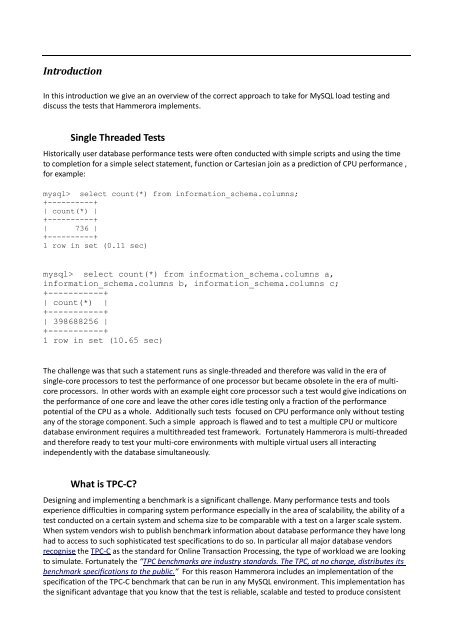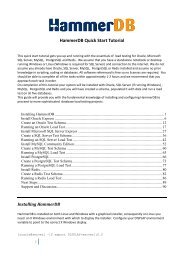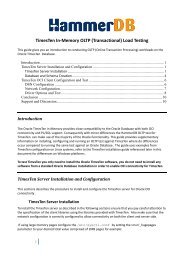MySQL OLTP (Transactional) - Hammerora - SourceForge
MySQL OLTP (Transactional) - Hammerora - SourceForge
MySQL OLTP (Transactional) - Hammerora - SourceForge
Create successful ePaper yourself
Turn your PDF publications into a flip-book with our unique Google optimized e-Paper software.
Introduction<br />
In this introduction we give an an overview of the correct approach to take for <strong>MySQL</strong> load testing and<br />
discuss the tests that <strong>Hammerora</strong> implements.<br />
Single Threaded Tests<br />
Historically user database performance tests were often conducted with simple scripts and using the time<br />
to completion for a simple select statement, function or Cartesian join as a prediction of CPU performance ,<br />
for example:<br />
mysql> select count(*) from information_schema.columns;<br />
+----------+<br />
| count(*) |<br />
+----------+<br />
| 736 |<br />
+----------+<br />
1 row in set (0.11 sec)<br />
mysql> select count(*) from information_schema.columns a,<br />
information_schema.columns b, information_schema.columns c;<br />
+-----------+<br />
| count(*) |<br />
+-----------+<br />
| 398688256 |<br />
+-----------+<br />
1 row in set (10.65 sec)<br />
The challenge was that such a statement runs as single-threaded and therefore was valid in the era of<br />
single-core processors to test the performance of one processor but became obsolete in the era of multicore<br />
processors. In other words with an example eight core processor such a test would give indications on<br />
the performance of one core and leave the other cores idle testing only a fraction of the performance<br />
potential of the CPU as a whole. Additionally such tests focused on CPU performance only without testing<br />
any of the storage component. Such a simple approach is flawed and to test a multiple CPU or multicore<br />
database environment requires a multithreaded test framework. Fortunately <strong>Hammerora</strong> is multi-threaded<br />
and therefore ready to test your multi-core environments with multiple virtual users all interacting<br />
independently with the database simultaneously.<br />
What is TPC-C?<br />
Designing and implementing a benchmark is a significant challenge. Many performance tests and tools<br />
experience difficulties in comparing system performance especially in the area of scalability, the ability of a<br />
test conducted on a certain system and schema size to be comparable with a test on a larger scale system.<br />
When system vendors wish to publish benchmark information about database performance they have long<br />
had to access to such sophisticated test specifications to do so. In particular all major database vendors<br />
recognise the TPC-C as the standard for Online Transaction Processing, the type of workload we are looking<br />
to simulate. Fortunately the “TPC benchmarks are industry standards. The TPC, at no charge, distributes its<br />
benchmark specifications to the public.” For this reason <strong>Hammerora</strong> includes an implementation of the<br />
specification of the TPC-C benchmark that can be run in any <strong>MySQL</strong> environment. This implementation has<br />
the significant advantage that you know that the test is reliable, scalable and tested to produce consistent




